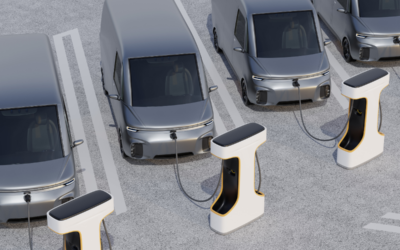Introduction: The Electric Fleet Revolution
Electric vehicles (EVs) are no longer a futuristic concept—they’re a present-day reality reshaping the transportation landscape. For businesses managing fleets, the shift towards electrification offers compelling advantages, from cost savings to environmental benefits. As global EV sales surpassed 17 million units in 2024, accounting for over 20% of new car sales worldwide , it’s evident that the momentum is building. But the question remains: Is your business prepared to embrace this transformation?(IEA)
Why Businesses Are Transitioning to Electric Fleets
1. Cost Efficiency
One of the most significant drivers for adopting electric fleet vehicles is the potential for cost savings. EVs typically have lower operating costs compared to internal combustion engine (ICE) vehicles. Businesses report up to a 55% reduction in fuel expenses after transitioning to electric or hybrid fleets .(Blink Charging, Cardata)
2. Environmental Responsibility
Switching to electric vehicles demonstrates a commitment to sustainability. EVs produce zero tailpipe emissions, contributing to improved air quality and reduced greenhouse gas emissions. This aligns with global efforts to combat climate change and can enhance a company’s corporate social responsibility profile.
3. Regulatory Compliance
Governments worldwide are implementing stricter emissions regulations. In the UK, for instance, low-emission zones are becoming more prevalent, and EVs are often exempt from congestion charges and other penalties . Adopting electric fleets can help businesses stay ahead of regulatory changes and avoid potential fines.(Financial Times, sopp + sopp)
4. Enhanced Brand Image
Operating an electric fleet can bolster a company’s brand image, showcasing innovation and environmental stewardship. This can be a differentiator in competitive markets, appealing to eco-conscious consumers and partners.
Challenges in Transitioning to Electric Fleets
While the benefits are clear, transitioning to an electric fleet comes with challenges:(Michelin Connected Fleet)
- Upfront Costs: The initial investment for EVs and charging infrastructure can be substantial.
- Charging Infrastructure: Establishing adequate charging facilities requires careful planning and investment.
- Range Limitations: Although EV ranges are improving, they may still be a concern for certain operational needs.
- Vehicle Availability: Depending on the region, there may be limited availability of suitable electric commercial vehicles.
Addressing these challenges involves strategic planning, leveraging government incentives, and partnering with experienced providers.
Comparative Overview: Electric vs. Internal Combustion Engine Fleets
| Aspect | Electric Vehicles (EVs) | Internal Combustion Engine (ICE) Vehicles |
|---|---|---|
| Fuel Costs | Lower (electricity is cheaper than fuel) | Higher (subject to fuel price volatility) |
| Maintenance | Lower (fewer moving parts) | Higher (more complex engine systems) |
| Emissions | Zero tailpipe emissions | High CO₂ and other pollutants |
| Regulatory Compliance | Easier compliance with emissions regulations | Increasingly challenging |
| Initial Investment | Higher upfront cost | Lower upfront cost |
| Operational Range | Improving, but may be limited for long distances | Generally longer range |
Preparing Your Business for the Transition
- Conduct a Fleet Assessment: Evaluate your current fleet’s usage patterns to identify suitable candidates for electrification.
- Explore Incentives: Research government grants, tax credits, and other incentives available for EV adoption.
- Plan Infrastructure: Develop a strategy for installing charging stations, considering location, capacity, and scalability.
- Pilot Programs: Start with a small-scale implementation to assess performance and gather data for broader rollout.
- Partner with Experts: Collaborate with fleet management and telematics providers, like Traknova, to ensure a smooth transition.
Conclusion: Embracing the Future
The shift to electric fleet vehicles is not just a trend—it’s an evolution in business operations aligning with economic, environmental, and regulatory imperatives. By proactively planning and leveraging available resources, your business can position itself at the forefront of this transformation.
Ready to Electrify Your Fleet?
Contact Traknova today to learn how our fleet management solutions can facilitate your transition to electric vehicles, ensuring efficiency, compliance, and sustainability.










